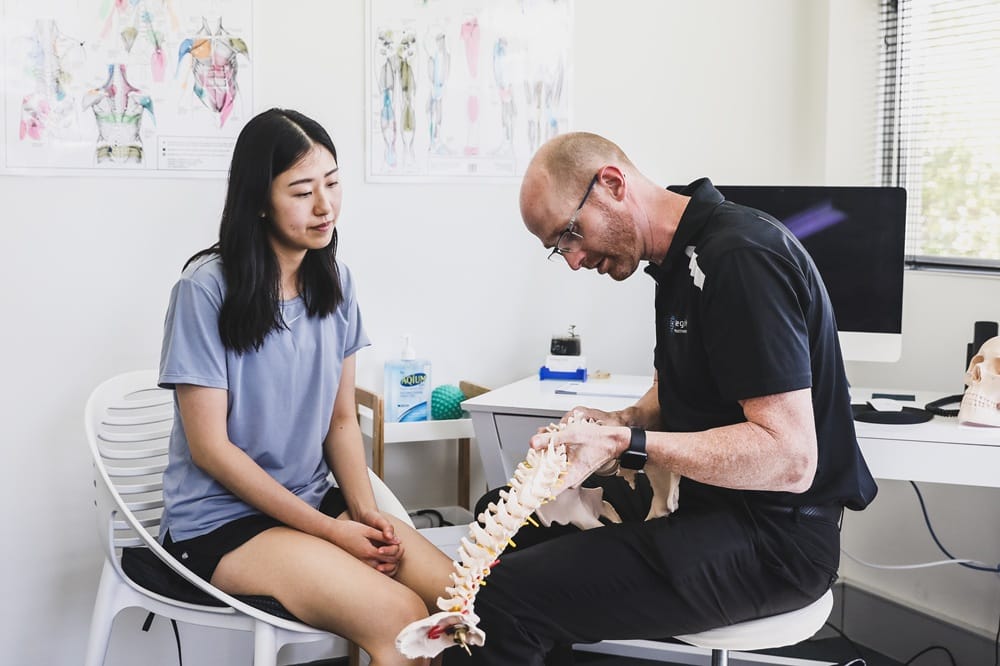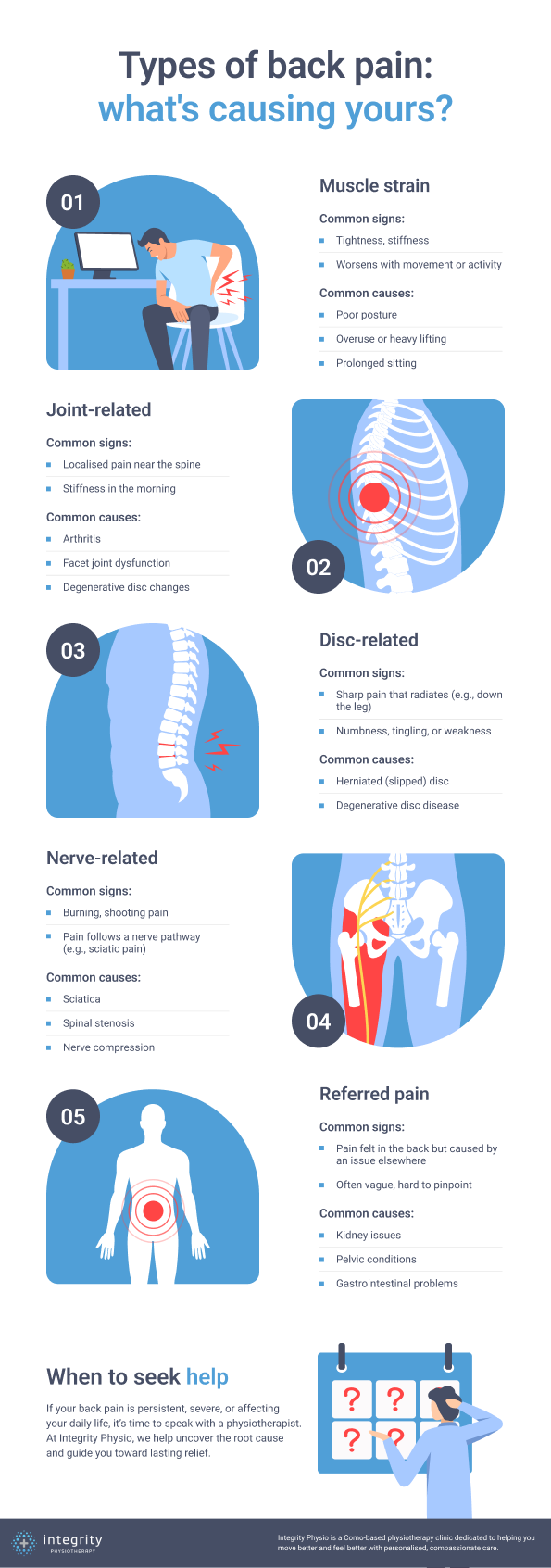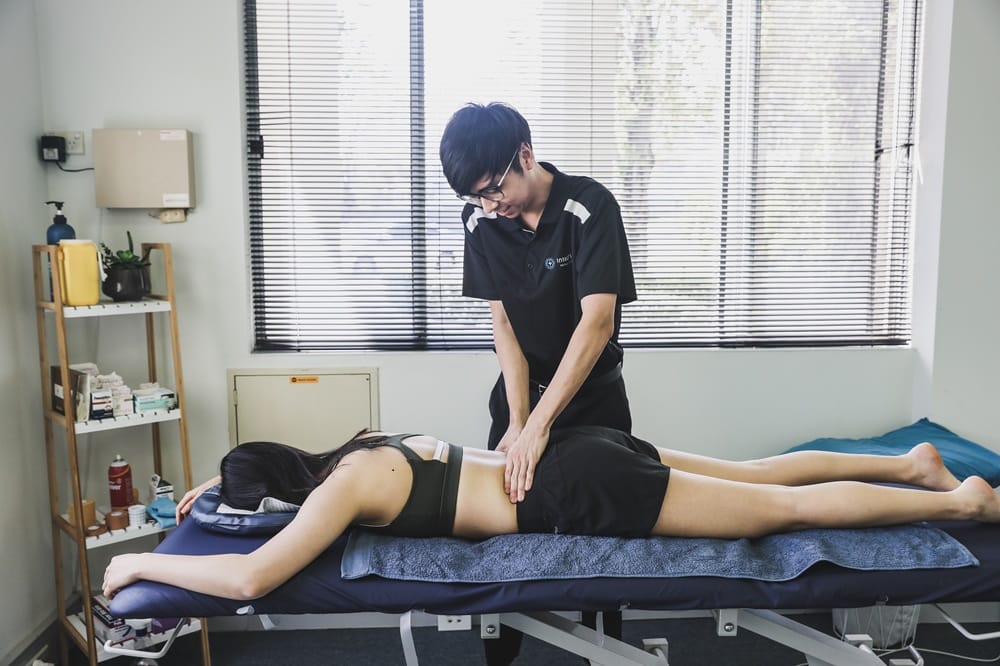
Back pain is one of the most common reasons people seek treatment, affecting people across all ages and lifestyles.
It can feel like a mild stiffness or a more intense, persistent pain that limits movement and everyday activity. For some, it builds up slowly from things like prolonged sitting or repetitive tasks. For others, it appears more suddenly after lifting, twisting, or physical strain.
Because back pain can show up in different ways and for different reasons, it’s not always easy to pinpoint what’s causing it, but finding that cause is key to lasting relief.
What are the different types of back pain?
Back pain can show up in different areas of the spine, and the location often gives clues about the underlying cause.
- Neck (Cervical) pain: Pain in the upper spine, often linked to poor posture, desk work, or stress. Can also involve stiffness, headaches, or nerve-related symptoms like tingling down the arms.
- Upper and middle back (Thoracic) pain: Less common than neck or lower back pain. This area is more stable, so pain here may be related to joint dysfunction, postural strain, or in some cases, more serious conditions like spinal fractures or inflammation.
- Lower back (Lumbar) pain: The most common type. Often caused by lifting, bending, prolonged sitting, or muscle imbalances. It can range from a dull ache to sharp pain that travels down the leg (sciatica).
- Pelvic or sacral pain: Pain around the base of the spine. This may relate to pelvic alignment, joint dysfunction (sacroiliac joint), or be influenced by pregnancy or certain sports.

Pain can also be classified by how long it lasts:
- Acute pain – Short-term, usually lasting a few days to a few weeks.
- Chronic pain – Lasts longer than three months and may come and go.
- Recurrent pain – Comes back in episodes, even if there are periods without symptoms.
Each type of pain may respond differently to treatment, which is why identifying the source is an important part of effective recovery.
Common causes of back pain
- Muscle strain or ligament sprain: Often the result of lifting, twisting, or sudden movement. These injuries can lead to inflammation, tightness, and restricted movement.
- Poor posture: Slouching at a desk, looking down at a phone, or standing unevenly can place repeated stress on the spine and surrounding muscles. Over time, this can cause pain and stiffness, especially in the neck and lower back.
- Degenerative disc changes: As we age, the discs that cushion the spine can wear down. This may cause no symptoms or it may lead to pain, reduced flexibility, or nerve compression.
- Spinal stenosis: This is a narrowing of the spinal canal that can press on the spinal cord or nerves. It’s more common in older adults and often causes numbness or weakness in the legs, especially when walking or standing for long periods.
- Herniated or bulging discs: The soft inner part of a disc can push out and irritate nearby nerves. This is a common cause of sciatica, where pain includes tingling or shooting sensations down the leg.
- Inflammatory conditions: Conditions like ankylosing spondylitis or other forms of spinal arthritis can lead to ongoing inflammation, stiffness, and pain that is often worse in the morning.
- Fractures or trauma: A fall, accident, or direct impact can cause compression fractures or vertebral damage, which may lead to severe, persistent pain.
- Other medical conditions: Osteoporosis, spinal infections, or even referred pain from the kidneys or pelvis can also contribute to back pain, though these are less common.
Pain is more common in people who have multiple contributing factors (for example, poor posture combined with inactivity or a physical job that involves repetitive lifting).
Symptoms to watch for
Paying attention to your symptoms can help determine whether the pain is muscular or related to something deeper like the spinal cord or nerves.
Common symptoms include:
- Aching, stiffness, or tightness in one area of the back
- Sharp or stabbing pain during movement, bending, or lifting
- Pain that radiates into the hips, legs, or feet (often from nerve irritation)
- Numbness or weakness in the legs or feet
- Difficulty standing up straight or walking for long periods
- Pain that worsens after sitting or standing still for too long
- Morning stiffness that improves with gentle activity
While many of these symptoms settle with rest and movement, some signs shouldn’t be ignored.
See a health professional if you notice:
- Pain that doesn’t improve after a few weeks
- Loss of sensation or coordination
- Ongoing numbness or weakness
- Bowel or bladder changes
- Unexplained weight loss, fever, or fatigue alongside back pain
These signs may point to deeper issues like nerve compression, spinal stenosis, or inflammation around the spinal cord. In these cases, early assessment is important (and that’s where physiotherapy plays a key role).
At Integrity Physiotherapy Como, we take the time to assess the root cause of your pain and identify any patterns that may point to more serious conditions. Some things are worth getting professional support for, and diagnosing complex back pain is one of them. If you’re unsure, we’re here to help guide you toward the next best step.
Who’s most at risk?
Back pain can affect anyone, but it’s more common in certain groups depending on lifestyle, age, and general health.
Pain is more common in people who:
- Spend long hours sitting – especially with poor posture or an unsupportive chair.
- Work in physical or repetitive jobs – such as trades, manual handling, or aged care roles.
- Lead a sedentary lifestyle – lack of movement can weaken the muscles that support your spine.
- Have a history of previous back injuries or recurring pain episodes.
- Experience high stress levels – tension and fatigue can increase muscular tightness.
- Are pregnant – changes in posture, joint laxity, and pelvic position can all increase load on the spine.
- Are over the age of 50 – degenerative changes in the spine become more common with age.
- Carry excess weight – which increases the strain on spinal joints and discs.
Some people are also at higher risk of developing conditions like disc degeneration or spinal stenosis, which may need ongoing management and monitoring.
Treatment and prevention tips

The right approach to treating back pain depends on what’s causing it, but there are some proven ways to reduce pain, improve movement, and prevent flare-ups.
Treatment options may include:
- Physiotherapy: A personalised treatment plan can help restore movement, reduce pain, and address underlying causes like muscle imbalances or joint restrictions. Manual therapy, dry needling, and targeted exercises are commonly used to improve outcomes.
- Movement and exercise: Gentle, consistent movement is often more effective than rest. Exercises that strengthen your core, improve mobility, and restore balance to the spine are key in recovery.
- Postural retraining: Poor posture can put repeated strain on your spine. Physios can help you understand your posture habits and teach you ways to sit, stand, and move more effectively throughout the day.
- Pain management techniques: Heat or cold packs, breathing exercises, and pacing strategies can all reduce pain and muscle tension without relying on medication.
Prevention strategies that may make a difference
- Keep active – regular low-impact activity (like walking or swimming) supports spinal health.
- Build strength gradually – focus on core and postural muscles, especially if your job or sport is demanding.
- Lift and move well – use your legs, avoid twisting, and don’t rush through repetitive tasks.
- Take breaks from sitting – changing positions regularly helps ease pressure on your spine.
- Manage stress – tension and fatigue can increase sensitivity to pain.
Make back pain one less thing to worry about
Back pain can feel limiting, but the right treatment can make a real difference. Physiotherapy plays an important role in treating back pain and reducing the risk of it returning. A targeted approach helps restore movement, build strength, and support long-term recovery.
If you’re dealing with pain that won’t settle or keeps coming back, now’s the time to act. At Integrity Physiotherapy, we offer personalised care and proven physiotherapy for back pain in Perth to help you move with confidence again.
Book an appointment today and let’s get you moving and feeling better!



